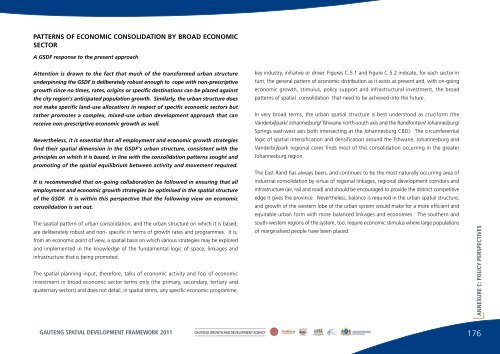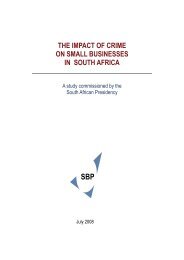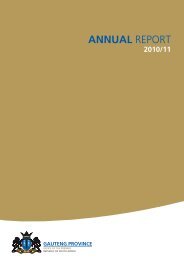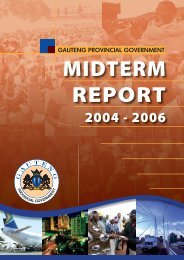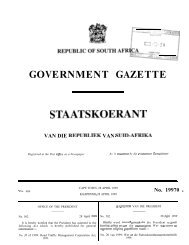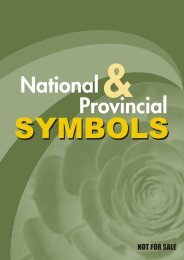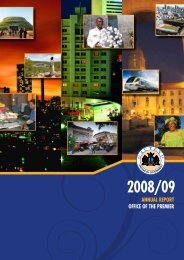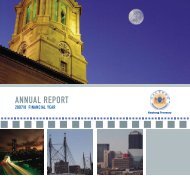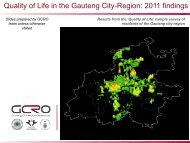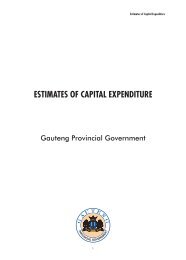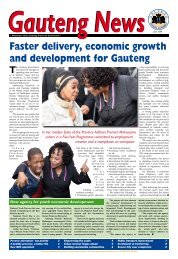the gauteng spatial development framework - Gauteng Online
the gauteng spatial development framework - Gauteng Online
the gauteng spatial development framework - Gauteng Online
Create successful ePaper yourself
Turn your PDF publications into a flip-book with our unique Google optimized e-Paper software.
PATTERNS OF ECONOMIC CONSOLIDATION BY BROAD ECONOMICSECTORA GSDF response to <strong>the</strong> present approachAttention is drawn to <strong>the</strong> fact that much of <strong>the</strong> transformed urban structureunderpinning <strong>the</strong> GSDF is deliberately robust enough to cope with non-prescriptivegrowth since no times, rates, origins or specific destinations can be placed against<strong>the</strong> city region's anticipated population growth. Similarly, <strong>the</strong> urban structure doesnot make specific land-use allocations in respect of specific economic sectors butra<strong>the</strong>r promotes a complex, mixed-use urban <strong>development</strong> approach that canreceive non-prescriptive economic growth as well.Never<strong>the</strong>less, it is essential that all employment and economic growth strategiesfind <strong>the</strong>ir <strong>spatial</strong> dimension in <strong>the</strong> GSDF's urban structure, consistent with <strong>the</strong>principles on which it is based, in line with <strong>the</strong> consolidation patterns sought andpromoting of <strong>the</strong> <strong>spatial</strong> equilibrium between activity and movement required.It is recommended that on-going collaboration be followed in ensuring that allemployment and economic growth strategies be optimised in <strong>the</strong> <strong>spatial</strong> structureof <strong>the</strong> GSDF. It is within this perspective that <strong>the</strong> following view on economicconsolidation is set out.The <strong>spatial</strong> pattern of urban consolidation, and <strong>the</strong> urban structure on which it is based,are deliberately robust and non- specific in terms of growth rates and programmes. It is,from an economic point of view, a <strong>spatial</strong> basis on which various strategies may be exploredand implemented in <strong>the</strong> knowledge of <strong>the</strong> fundamental logic of space, linkages andinfrastructure that is being promoted.The <strong>spatial</strong> planning input, <strong>the</strong>refore, talks of economic activity and foci of economicinvestment in broad economic sector terms only (<strong>the</strong> primary, secondary, tertiary andquaternary sectors) and does not detail, in <strong>spatial</strong> terms, any specific economic programme,key industry, initiative or driver. Figures C.5.1 and Figure C.5.2 indicate, for each sector inturn, <strong>the</strong> general pattern of economic distribution as it exists at present and, with on-goingeconomic growth, stimulus, policy support and infrastructural investment, <strong>the</strong> broadpatterns of <strong>spatial</strong> consolidation that need to be achieved into <strong>the</strong> future.In very broad terms, <strong>the</strong> urban <strong>spatial</strong> structure is best understood as cruciform (<strong>the</strong>Vanderbijlpark/ Johannesburg/ Tshwane north-south axis and <strong>the</strong> Randfontein/ Johannesburg/Springs east-west axis both intersecting at <strong>the</strong> Johannesburg CBD). The circumferentiallogic of <strong>spatial</strong> intensification and densification around <strong>the</strong> Tshwane, Johannesburg andVanderbijlpark regional cores finds most of this consolidation occurring in <strong>the</strong> greaterJohannesburg region.The East Rand has always been, and continues to be <strong>the</strong> most naturally occurring area ofindustrial consolidation by virtue of regional linkages, regional <strong>development</strong> corridors andinfrastructure (air, rail and road) and should be encouraged to provide <strong>the</strong> distinct competitiveedge it gives <strong>the</strong> province. Never<strong>the</strong>less, balance is required in <strong>the</strong> urban <strong>spatial</strong> structure,and growth of <strong>the</strong> western lobe of <strong>the</strong> urban system would make for a more efficient andequitable urban form with more balanced linkages and economies. The sou<strong>the</strong>rn andsouth-western regions of <strong>the</strong> system, too, require economic stimulus where large populationsof marginalised people have been placed.ANNEXURE C: POLICY PERSPECTIVESGAUTENG SPATIAL DEVELOPMENT FRAMEWORK 2011GAUTENG GROWTH AND DEVELOPMENT AGENCY176


